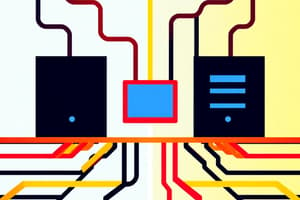Podcast
Questions and Answers
Match the network architecture with its description:
Match the network architecture with its description:
Peer to Peer = No need for full-time System Administrator Client-Server = Servers dedicated to managing disk drives, printers, or network traffic
Match the advantage/disadvantage with the correct network architecture:
Match the advantage/disadvantage with the correct network architecture:
Easy to install and configure = Peer to Peer Security vulnerabilities due to decentralized system = Peer to Peer Data recovery or backup difficulty = Peer to Peer Powerful servers managing network traffic = Client-Server
Match the characteristic with the correct network architecture:
Match the characteristic with the correct network architecture:
All resources and contents shared by all peers = Peer to Peer Each computer is either a client or a server = Client-Server Failure of one peer doesn’t affect other peers = Peer to Peer Difficult administration due to decentralized system = Peer to Peer
Match the component with its role in the network architecture:
Match the component with its role in the network architecture:
Match the statement about cost with the correct network architecture:
Match the statement about cost with the correct network architecture:
Match the following network architectures with their descriptions:
Match the following network architectures with their descriptions:
Match the following advantages of Client-Server Architecture with their descriptions:
Match the following advantages of Client-Server Architecture with their descriptions:
Match the following disadvantages of Client-Server Architecture with their descriptions:
Match the following disadvantages of Client-Server Architecture with their descriptions:
Match the following features of Intranet Network Architecture with their descriptions:
Match the following features of Intranet Network Architecture with their descriptions:
Match the following statements about Hybrid Network Architecture with their descriptions:
Match the following statements about Hybrid Network Architecture with their descriptions:
Flashcards are hidden until you start studying




